#Bromacker
Explore tagged Tumblr posts
Text
We are approaching the maximum of images you can post here so I thought it was time I make a little showcase of all the formation pieces we covered so far on the streams.

Chaneres Formation

Hanson Formation

Guimarota Formation

Winton formation

Holocene Madagascar

Riversleigh

Kimmeridge Clay

Tapinocephalus Assemblage Zone

Hunsrück Slate

Yixian Formation

Paja Formation

Besano Formation

Pebas megawetland

Fezouata Formation

Ngorora Formation

Kuldana Formation

Madygen Formation

Jebel Qatrani '

Holocene Cuba

Pierre Shale

Crato Formation

Archer City Formation

Tambach Formation

La Brea tar pits

Morrison Formation

Sannine Formation

Ballagan Formation

Shanwang Formation

Austrian Paratethys
For people who don't know: for several months now I draw one formation or fossil locality every Saturday. The next place we visit is chosen by a wheel of names, which we also constantly fill up again when a new formation is picked.
I try to make it as interesting as possible in my composition and choice of animals and I can tell you this series has been a great training when it comes to constructing these, how I call them, Menageries.
I have to thank a team of friends and colleagues who help behind the scenes with research, creation of size charts and conversation partners when it comes to deciding on the compositions of these pieces. Their help has been invaluable!
#paleoart#sciart#paleostream#palaeoblr#cretaceous#dinosaur#jurassic#pterosaur#sauropod#formations#miocene#eocene#triassic#devonian#carboniferous#labrea#morrison#bromacker#permian#deeptime#scicomm
13K notes
·
View notes
Text
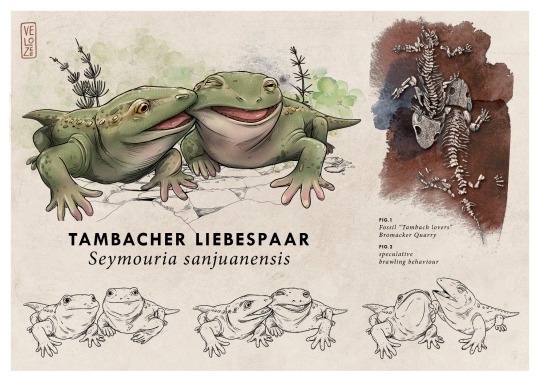
Happy Valentines Day
Here is my favorite couple from Thuringia, the Tambacher Liebespaar (tambach lovers). A fossil of two skeletons of Seymouria sanjuanensis from the Bromacker quarry
#digital illustration#velozee#paleoart#paleontology#permian#fossil#illustration#Seymouria#Seymouria sanjuanensis#Tambacher Liebespaar#Bromacker#Valentines Day
1K notes
·
View notes
Text


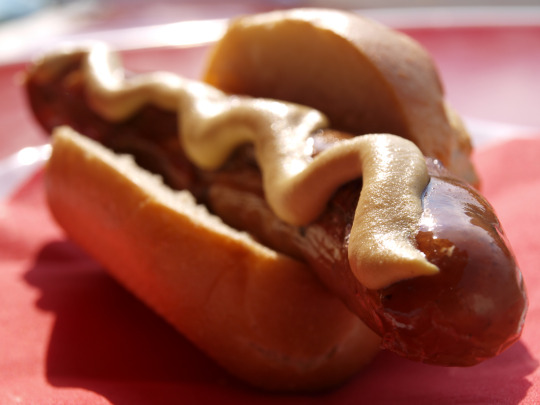
Thuringian bratwurst, one of the most famous regional fast food staples in Germany, has been honored in paleontology. In the 1990s, a team of American paleontologists discovered a novel species of ancient dinosaurs embedded in the rotliegend rocks of Bromacker quarry near Tambach-Dietharz in Thuringia. To honor the delicious bratwurst they frequently had while working in the quarry, they named the fossil Tambachia trogallas. While the genus name obviously comes from the town of Tambach, the species name is a composite of two greek words: trogo (τρογο) meaning to munch, and allas (ἀλλας) meaning sausage. This way, the name of the fossil translates to "the sausage muncher of Tambach".
(source)

142 notes
·
View notes
Text

Eudibamus & Un-Finished Bromacker Formation Sketches - by Bálint Benke
7 notes
·
View notes
Photo
Funny enough that exactly what you see here, D. teutonis. Devil of the Bromacker



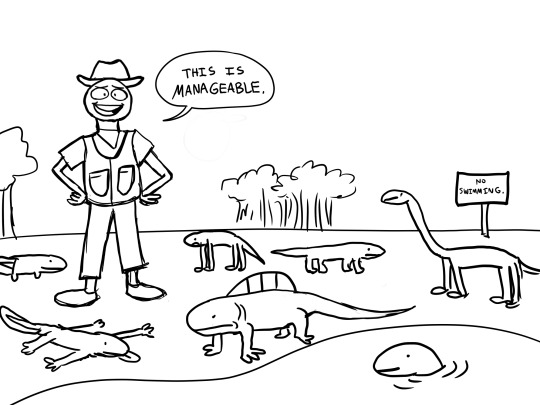
I’m just saying that maybe it wouldn’t have turned out quite as bad.
93K notes
·
View notes
Text
The Bromacker Fossil Project Part XII: Tambacarnifex unguifalcatus, the Tambach executioner

Holotype specimen of Tambacarnifex unguifalcatus, preserved in couterparts. Photographs by Dave Berman, 2010.
Tambacarnifex unguifalcatus was discovered by Thomas Martens and his father Max in 1995 in the same pocket of fossils from which the first-discovered specimen of the herbivorous basal synapsid Martensius bromackerensis was recovered. Because numerous fossil animals were jumbled together, Thomas and Max weren’t able to collect individual specimens from the bone pocket using our standard technique of surrounding a specimen in a plaster and burlap jacket. Instead, they collected all the individual pieces of rock that contained bone or at least appeared to contain bone, as most rock pieces were coated in goopy mud. Thomas cleaned the rock pieces with water to reveal the bone, and then pieced together the various specimens.
He eventually sent us the specimen that became the holotype of Tambacarnifex, along with pieces that he thought might go with it. Dave and I spent hours piecing together the remainder of the skeleton, and we searched the collections at the Museum der Natur, Gotha for missing pieces in subsequent field seasons. The majority of the specimen was recovered, but the skull, a few vertebrae, and distal finger and toe bones are missing. A rock piece with the greater portion of a lower jaw with teeth was also collected from the bone pocket, though it couldn’t be associated with the skeleton and may represent a second individual. A lot of bone was lost from the specimen, but impressions of missing bone were preserved, which proved useful for identifying wrist and ankle bones, among others. Dave used a white pencil to color in the bone impressions so they would stand out for study and in photographs of the specimen. Ultimately, we realized that Martensius and Tambacarnifex were preserved one on top of the other, though separated by several inches of rock.

The lower jaw piece of Tambacarnifex unguifalcatus. Photograph by Dave Berman, 2008.
The teeth of Tambacarnifex preserved in the lower jaw are strongly recurved and flattened side-to-side, which, along with other features preserved in the skeleton, indicate it is a member of the basal synapsid group (family) Varanopidae and in the subfamily Varanopinae. The Varanopidae have been likened to the actively predaceous modern monitor lizards in the family Varanidae, hence the similar name. Varanopids were the most diverse and longest-surviving basal synapsids, being known from the Late Carboniferous–Middle Permian (~309–260 million years ago) of North America, Europe, Asia, and Africa. With their sharp, recurved teeth and a gracile skeleton, scientists think varanopids were agile predators, at least compared to other animals of their time. They range from about 12–78 inches in length, with the smallest ones probably being insectivorous and the larger ones carnivorous. Tambacarnifex has an estimated body size of about 35 inches, and as a medium-sized varanopid with gracile limbs it would have been an agile carnivore, preying on on any of the Bromacker vertebrates that it could catch.

An articulated but incompletely preserved series of 11 vertebrae of Tambacarnifex unguifalcatus. Notice that the neural spines are low and subrectangular, so it is unlikely that they supported a sail, as occurs in some other basal synapsids such as Dimetrodon teutonis. The front of the animal is to the left. Photo by Dave Berman, 2008.
Unlike Dimetrodon teutonis, the other apex predator at the Bromacker, Tambacarnifex has broad, low neural spines that alternate in height. It differs from other varanopines in the shape and anterior inclination of its neural spines and in having greatly elongated and recurved bony claw supports in its hands and feet. The generic name Tambacarnifex was coined in reference to its position in the food chain: “Tamba,” for the Tambach Basin, which the holotype inhabited, and the Latin “carnifex,” meaning executioner, for its role as an apex predator. “Unguifalcatus” was derived from the Latin “unguis,” nail or claw, and “falcatus,” meaning sickle-shaped, in reference to the long, strongly recurved bony claw supports.

Incomplete front (left) and hind (right) feet of Tambacarnifex unguifalcatus. Notice the extremely long bony claw supports preserved on the first, third, and fourth fingers of the front foot and the fourth toe of the hind foot. I–V refer to finger and toe numbers. Photos by Dave Berman, 2008.

Illustration of Tambacarnifex unguifalcatus consuming a Dimetrodon teutonis carcass. Outline drawing by Matt Celeskey, colored (with permission) by Carnegie Museum of Natural History Vertebrate Paleontology Scientific Illustrator Andrew McAfee.
Stay tuned for the final post of this series, which will summarize what we’ve learned about the Bromacker. Click here if you would like to download your own copy of the outline drawing of Tambacarnifex consuming Dimetrodon to color in. The paper describing Tambacarnifex unguifalcatus can be viewed by clicking here.
Amy Henrici is Collection Manager in the Section of Vertebrate Paleontology at Carnegie Museum of Natural History. Museum employees are encouraged to blog about their unique experiences and knowledge gained from working at the museum.
#Carnegie Museum of Natural History#Paleontology#Vertebrate Paleontology#Bromacker#Bromacker quarry#Fossils#Tambacarnifex unguifalcatus
38 notes
·
View notes
Photo

So i made something for the Bromacker contest.... I'm not much of a paleoartist, but hey, I tried.Sleeping Dimetrodon teutonis and nosy Eudibamus.
388 notes
·
View notes
Text
https://newyork10002.blogspot.com/p/bromack-dr-se-atlanta-georgia-consumer.html
https://newyork10002.blogspot.com/p/bromack-dr-se-atlanta-georgia-consumer.html https://unitedstatesconsumercreditcounseling.blogspot.com/p/plantersville-mississippi-consumer.html
via https://newyork10002.blogspot.com/p/bromack-dr-se-atlanta-georgia-consumer.html November 23, 2019 at 07:47PM Copyright © November 23, 2019 at 07:47PM
0 notes
Photo
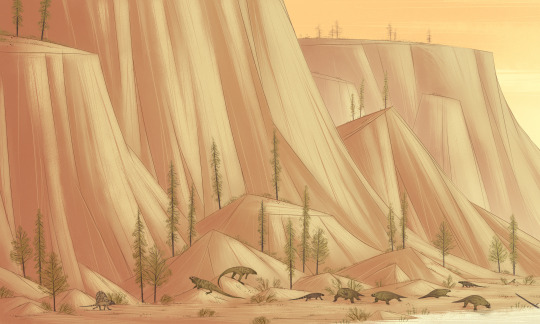


My submission for the Bomacker paleoart contest. Depicts various animals known from the early Permian environment of the Bromacker locality of the Tambach formation.
192 notes
·
View notes
Text
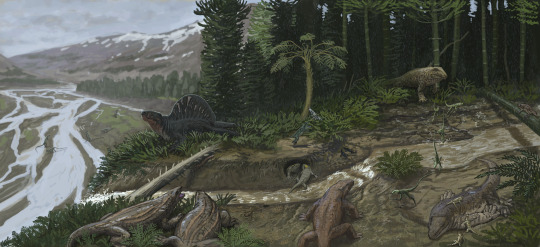
Result from the Bromacker #Paleostream
It's been a while since we were able to put nearly all animals onto a formation piece!

It was a joy to put this one together because it felt a little like coming home. #Paleostream has a long history with this locality.

I already made this size chart years ago but parts of it were kind of eye balled back then and so I put together a second version

#paleoart#sciart#paleostream#palaeoblr#dinosaur#not a dinosaur#dimetrodon#permian#diadectes#bromacker#orobates#german wilderness
232 notes
·
View notes
Text

Happy International Womans Day and happy #fossilfriday
I am very happy to announce that my artwork "Dance in the dust" won the audience choice award for paleoart at the Visual Conference For Women Archaelogists And Paleontologists (VCWAP).
While the artwork did not convince the jury of the Bromacker Paleoart Contest for which is was originally created I am really happy that the audience of the congress found my art award worthy.🎉
The artwork can still be seen at the Bromacker Lab at Schloss Friedenstein in Gotha and if you want to know more about permian critters from thuringia then check out the Bromacker project
#digital illustration#paleoart#paleontology#permian#bromacker#fossil#seymouria#Dimetrodon#Ursaurier#Velozee
111 notes
·
View notes
Text
Tiffany Bromack Death - Obituary : Tiffany Bromack Has Died
Tiffany Bromack Death Notice - Obituary, Funeral, Cause Of Death Through a social media announcement, DeadDeath learned on February 8th, 2021, about the death of Tiffany Bromack who has died...Read more
Tiffany Bromack Death Notice – Obituary, Funeral, Cause Of Death Through a social media announcement, DeadDeath learned on February 8th, 2021, about the death of Tiffany Bromack who has died. In the mourning spirit of this death, families, friends and associates of the deceased share their sad news across social media timelines. It is really a difficult time for the beloved ones of Bromack whose…

View On WordPress
0 notes
Text
Forscher der Uni Jena an Citizen-Science-Projekt auf dem Bromacker beteiligt

Fenster zur frühen Evolution der Landwirbeltiere Mit dem Projekt „Bromacker“ ist jetzt eine neuartige, wissenschaftliche Kooperation an der weltweit einzigartigen Fossillagerstätte „Bromacker“ im Thüringer Wald gestartet. Nach mehr als einem Jahrzehnt gibt es dort erstmals wieder systematische Ausgrabungen und geologische Bohrungen. Aber nicht nur das: Das Ziel der Kooperation ist es, anhand der Fossillagerstätte „Bromacker“ Forschung und Wissensvermittlung so miteinander zu verzahnen, dass die Öffentlichkeit ein Fenster zur frühen Evolution der Landwirbeltiere bekommt. In den kommenden fünf Jahren arbeiten hierfür das Museum für Naturkunde Berlin – Leibniz-Institut für Evolutions- und Biodiversitätsforschung, die Stiftung Schloss Friedenstein Gotha, die Friedrich-Schiller-Universität Jena und der Nationale GeoPark Thüringen Inselsberg-Drei Gleichen zusammen. Das deutschlandweit einzigartige Forschungsprojekt wird vom Bundesministerium für Bildung und Forschung gefördert. Neue Arten der Wissenschaftskommunikation Forschende werden geologischen, taxonomischen, paläoökologischen und physiologischen Fragen nachgehen, um in Zukunft das Leben an der Fossillagerstätte „Bromacker“ als Ganzes besser zu verstehen. Mit neuen Arten der Wissenschaftskommunikation nimmt die Öffentlichkeit am Forschen teil und kommt mit Forschenden ins Gespräch. #DreidimensionaleFossilien #ForscherderUniJenaanCitizenScienceProjektaufdemBromackerbeteiligt #NeueArtenderWissenschaftskommunikation Lesen Sie den ganzen Artikel
0 notes
Text
The Bromacker Fossil Project Part XI: Dimetrodon teutonis, an apex predator
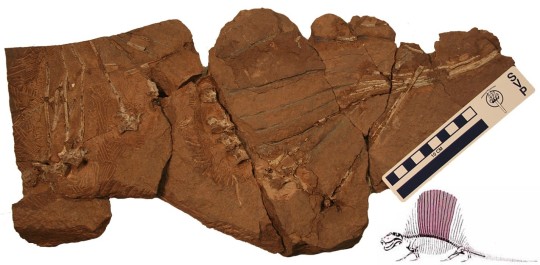
Holotype specimen of Dimetrodon teutonis, which consists of a partial vertebral column. The preserved portion of this vertebral column is highlighted in the reconstruction of Dimetrodon (lower right). Photograph by the author, 2007. Dimetrodon reconstruction modified from Romer and Price, 1940.
Specimens of two top predators have been discovered at the Bromacker quarry. Like Martensius, both are basal members of the group Synapsida, the later members of which gave rise to mammals. You might be familiar with one of them – Dimetrodon, a synapsid sometimes incorrectly portrayed with dinosaurs, which carried a tall sail on its back that was supported by bony spines. The other is a new genus and species that will be presented in my next post.
The fossil pictured above, the first-discovered specimen of Dimetrodon from the Bromacker quarry, may not look like much, but it was the first record of Dimetrodon outside of North America. The circumstances under which it was found were very different from the discovery of other fossils from the Bromacker quarry. Before Dave Berman and I arrived for the 1999 field season, Thomas Martens noticed that someone, possibly a fossil poacher, had been in the quarry overnight and knocked some rocks off the quarry lip. The rocks apparently broke upon hitting the ground, which exposed some bones. Thomas carefully picked them up and took them to his lab at the Museum der Natur, Gotha (MNG). When Dave and I met Thomas at the quarry on our first day of the field season, Thomas mentioned the find and told us that he thought the bones were ribs. We didn’t think much of it, other than horror at learning a fossil poacher might have visited the quarry overnight, one of our worst fears.
As planned, Dave and I spent the last day of the field season in the museum collections, and when Thomas let us in that morning, he reminded us to look at the potential ribs and told us where they were. Shortly after we began examining them, Dave and I simultaneously realized that the “ribs” were actually spines of Dimetrodon. We couldn’t believe our eyes, because of all the Early Permian fossils known from North America, Dimetrodon was Thomas’ favorite. Indeed, he’d used an image of it on signs at the Bromacker and included a model of Dimetrodon in a diorama, once on display in the MNG, that showed models of Bromacker animals in their environment. Thomas jumped for joy later that day when we gave him the news.
So how did Dave and I so quickly realize that the “ribs” were spines of Dimetrodon? Besides Dimetrodon, some other basal synapsids had sails, the function of which remains unknown, though scientists have speculated they could’ve been used for display or regulating body temperature. The spines (known as neural spines) supporting the sails vary in shape and length, with those of Dimetrodon and its herbivorous relative Edaphosaurus being tall and narrow, and those of another relative, the carnivorous Sphenacodon, being shorter and blade-like. Neural spines of Dimetrodon are easy to distinguish, because in addition to being long they bear fore and aft grooves, which create a dumbbell-shaped cross-sectional outline, and they lack the ‘crossbars’ that occur on the long neural spines of Edaphosaurus. When Dave and I saw the fore and aft grooves, the dumbbell-shaped cross-sectional outline of some broken spine ends, and an absence of crossbars, we knew that the “ribs” were indeed spines of Dimetrodon.

Flesh reconstructions of Sphenacodon sp. (left) Dimetrodon grandis (middle) and Edaphosaurus pogonias (right) to show the differences between their sails. Note that Dimetrodon and Sphenacodon are more closely related to one another than they are to Edaphosaurus, despite their different sail shapes. Reconstructions of Sphenacodon and Dimetrodon by Dmitry Bogdanov and that of Edaphosaurus by Nobu Tamura, all from Wikimedia Commons.
The Bromacker Dimetrodon is considerably smaller than other known species of the genus, and this is one character among other more detailed anatomical features that distinguishes it. For the new species name, Dave selected the Latin “teutonis,” which means an individual of a German tribe, in reference to the geographic origin of the holotype specimen.
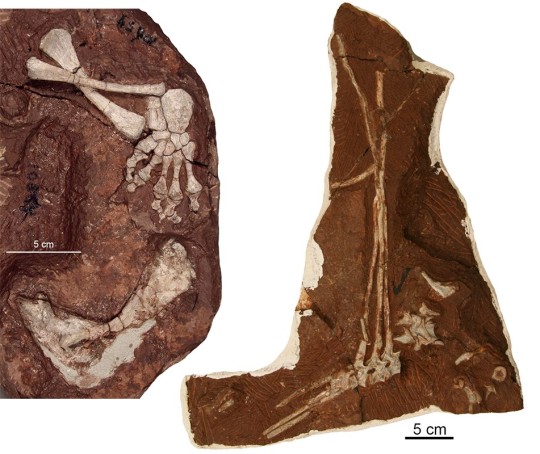
Two additional specimens of Dimetrodon teutonis. Left, hindleg and shoulder girdle bone (fused scapulocoracoid) and right, several vertebrae bearing complete to nearly complete neural spines of an individual that was larger and presumably more mature than the holotype. Photographs by the author, 2007.
Dave was able to use a mathematical equation involving measurements of the vertebrae to estimate the holotype’s weight as a living animal at 31 pounds. In contrast, other known Dimetrodon species have estimated weights of about 81–550 pounds. We later discovered additional partial specimens of Dimetrodon at the Bromacker quarry, and Dave estimated the weight of the largest specimen with vertebrae at 53 pounds, still considerably less than that of what had previously been the smallest species, D. natalis from Texas. Dimetrodon is otherwise known from numerous species from the American mid-continent and southwest that generally got larger through time.
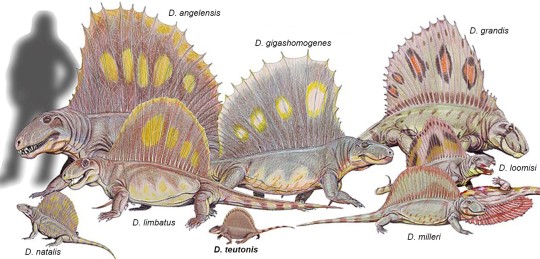
Reconstructions of various species of Dimetrodon drawn to scale. The diminutive D. teutonis is at bottom center and D. natalis, no longer the smallest species, is at bottom left. Illustration adapted from Dmitry Bogdanov via Wikimedia Commons.
All Dimetrodon species have teeth adapted for meat-eating in being teardrop-shaped with sharp edges for slashing flesh. By size and jaw position these sharp teeth are divided into precanines, canines, and postcanines of varying numbers. Unlike D. teutonis, some species even had fine serrations on their tooth edges. The only known upper jaw bone of Dimetrodon teutonis clearly has two canines, but one is missing and represented by a large gap in the tooth row that would have accommodated this tooth. The second canine is represented only by its broad base, but it too must have been large. Although it was a small animal, the teeth of D. teutonis indicate that it was a meat-eater and as such would have preyed on other vertebrates from the Bromacker, many of which were even smaller.

Diagrammatic drawing of the skull of Dimetrodon (left) and photograph of the maxilla or upper jaw bone (right) of D.teutonis. Abbreviations: c, canine; pc, postcanine; prc, precanine. Photographs by the author, 2007. Drawing of skull from Wikimedia Commons.
Stay tuned for my next post, which will be about the second-known apex carnivore from the Bromacker. In the meantime, here are links to scientific papers on Dimetrodon teutonis:
https://www.researchgate.net/publication/325670232_A_new_species_of_Dimetrodon_Synapsida_Sphenacodontidae_from_the_Lower_Permian_of_Germany_records_first_occurrence_of_genus_outside_of_North_America
https://www.researchgate.net/publication/288544821_New_materials_of_Dimetrodon_teutonis_Synapsida_Sphenacodontidae_from_the_Lower_Permian_of_Germany
Amy Henrici is Collection Manager in the Section of Vertebrate Paleontology at Carnegie Museum of Natural History. Museum employees are encouraged to blog about their unique experiences and knowledge gained from working at the museum.
#Carnegie Museum of Natural History#Dimetrodon#Fossils#Bromacker#Bromacker Quarry#Apex predator#Paleontology
37 notes
·
View notes
Text
Fighting the bromack with a fucking sniper and pistol!
When you get to that point in a video game where you’re repeatedly chanting ‘No’ so quickly, you sound like a revving engine.
40 notes
·
View notes
Text
3D 列印重現 2.9 億年前化石古生物漫步的姿態!
3D 列印重現 2.9 億年前化石古生物漫步的姿態!
生物的演化與進化向來都生物學家們最有興趣研究課題,而在演化成爬行動物之前,有個很重要的階段就是「Amniote 羊膜動物」的出現,這些動物可以在陸地上成長,不需要像兩棲類生物經過水生幼體的過度階段。
最近就有古生物學家利用 3D 列印讓德國中部的 Bromacker 採石場發現有 2.9億年歷史的 Orobates pabsti 羊膜動物化石重現走路漫步的姿態。 (more…)
View On WordPress
0 notes